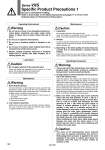
7-p0172-0189-vxs22_en 16 / 19
10秒後にBOOKのページに移動します
1. Do not use the valves in an atmosphere having corrosive gases, chemicals, sea water, water, water steam, or where there is direct contact with any of these. 2. Do not use in explosive atmospheres. 3. Do not use in locations subject to vibration or impact. 4. Do not use in locations where radiated heat will be received from nearby heat sources. 5. Employ suitable protective measures in locations where there is contact with water droplets, oil or welding spatter, etc. Operating Environment Warning 1. Lubrication Do not apply lubricant to the solenoid valve. Scale and sludge are generated by the reaction of oil and steam, and cause destruction and malfunction. 2. Storage In case of long term storage after use with heated water, thoroughly remove all moisture to prevent rust and deterioration of rubber materials, etc. 3. Depending on the water quality, the brass body may corrode due to dezincification, causing internal leakage. Inspect the product once every six months. If any problem is found, replace it with a product with a stainless steel body. Caution 1. Valves will reach high temperatures from high temperature fluids. Use caution, as there is a danger of being burned if a valve is touched directly. 2. Arrange piping so that condensate will not accumulate in the solenoid valve. Install the piping to the solenoid valve higher than peripheral piping. Be sure to avoid installing the piping to the solenoid valve at the lowest part of the piping layout. If condensate accumulates in the solenoid valve or peripheral piping, the steam entering the piping will cause steam hammer. This will lead to destruction and malfunction of the solenoid valve and piping. If steam hammer causes problems, install by-pass piping to thoroughly discharge condensate from the piping. Apply steam to the device afterwards to start operation. 3. Make sure when using pilot type 2-port solenoid valves that the flow direction is from 1 (IN) to 2 (OUT). The valve is designed based on a flow direction of 1 (IN) to 2 (OUT) and harnesses the fluid pressure of port 1 (IN) when the valve opens or closes. If reverse pressure (2 (OUT) to 1 (IN)) is applied, it may lead to a reduced service life or cause damage to parts early on due to chattering or pulses from the main valve (diaphragm, piston, etc.). If there is a possibility that reverse pressure will be applied, take countermeasures by installing the check valve, etc. at the downstream side. When installing the check valve, allow ample space between the valve and the check valve. If it is placed near the valve, it may cause chattering and pulses in the main valve. Warning 1. The valve of the pilot-operated 2-port solenoid valve may be opened momentarily and result in fluid leakage when pressure is applied to the valve suddenly (if the pump or supply valve starts, for example) while the valve is closed. Please be cautious of this. Caution 1. Removing the product The valve will reach a high temperature when used with high temperature fluids. Confirm that the valve temperature has dropped sufficiently before performing work. If touched inadvertently, there is a danger of being burned. 1. Shut off the fluid supply and release the fluid pressure in the system. 2. Shut off the power supply. 3. Dismount the product. 2. Low frequency operation Switch valves at least once every 30 days to prevent malfunction. Also, in order to use it under the optimum state, conduct a regular inspection once a half year. Warning 1. Do not apply lubricant to the solenoid valve. Scale and sludge are generated by the reaction of oil and steam, and cause destruction and malfunction. Do not apply lubricant to the solenoid valve. Lubrication Caution Maintenance Maintenance Operating Precautions Series VXS Specific Product Precautions 1 Be sure to read before handling. Refer to front matter 41 for Safety Instructions and pages 17 to 19 for 2 Port Solenoid Valves for Fluid Control Precautions. 186